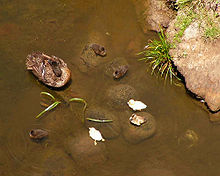| Chestnut teal | |
|---|---|

| |
| Male | |

| |
| Female | |
| Conservation status | |
 Least Concern (IUCN 3.1) | |
| Scientific classification | |
| Domain: | Eukaryota |
| Kingdom: | Animalia |
| Phylum: | Chordata |
| Class: | Aves |
| Order: | Anseriformes |
| Family: | Anatidae |
| Genus: | Anas |
| Species: | A. castanea |
| Binomial name | |
| Anas castanea (Eyton, 1838) | |
The chestnut teal (Anas castanea) is a dabbling duck found in Australia. It is protected under the National Parks and Wildlife Act 1974.
Taxonomy
The chestnut teal was described by the English naturalist Thomas Campbell Eyton in 1838 under the binomial name Mareca castanea. The specific epithet castanea is from the Latin castaneus for "chestnut-coloured" or "chestnut-brown".
A large molecular phylogentic study that compared mitochondrial DNA sequences from ducks, geese and swans in the family Anatidae found that the chestnut teal is a sister species to the Sunda teal (Anas gibberifrons) that is endemic to Indonesia.
Description
The chestnut teal is darker and a slightly bigger bird than the grey teal.
The male has a distinctive green coloured head and mottled brown body. The female has a brown head and mottled brown body. The female is almost identical in appearance to the grey teal.
The female chestnut teal has a loud penetrating "laughing" quack repeated rapidly nine times or more.
Distribution and habitat

The chestnut teal is commonly distributed in south-eastern and south-western Australia, while vagrants may occur elsewhere. Tasmania and southern Victoria are the species' stronghold, while vagrants have been found as far north as New Guinea and Lord Howe Island, and as far south as New Zealand.
The chestnut teal prefers coastal estuaries and wetlands, and is indifferent to salinity. This bird is an omnivore.
Breeding
Chestnut teals form monogamous pairs that stay together outside the breeding season, defend the nest site and look after the young when hatched. Nests are usually located over water, in a down-lined tree hollow about 6–10 m high. Sometimes nests are placed on the ground, among clumps of grass near water. The young hatch and are ready to swim and walk within a day.
See also
References
- BirdLife International (2016). "Anas castanea". IUCN Red List of Threatened Species. 2016: e.T22680277A92853345. doi:10.2305/IUCN.UK.2016-3.RLTS.T22680277A92853345.en. Retrieved 12 November 2021.
- Eyton, Thomas Campbell (1838). A Monograph on the Anatidae, or Duck Tribe. London: Longman, Orme, Brown, Green, & Longman. p. 119.
- Jobling, James A. (2010). The Helm Dictionary of Scientific Bird Names. London: Christopher Helm. p. 93. ISBN 978-1-4081-2501-4.
- Gonzalez, J.; Düttmann, H.; Wink, M. (2009). "Phylogenetic relationships based on two mitochondrial genes and hybridization patterns in Anatidae". Journal of Zoology. 279 (3): 310–318. doi:10.1111/j.1469-7998.2009.00622.x.
- ^ "Chestnut Teal". Victoria State Government: Game Management Authority. Archived from the original on 10 August 2017. Retrieved 9 August 2017.
- ^ "Chestnut Teal". Birds in Backyards. Archived from the original on 8 September 2012. Retrieved 27 January 2012.
External links
 Media related to Anas castanea at Wikimedia Commons
Media related to Anas castanea at Wikimedia Commons Data related to Anas castanea at Wikispecies
Data related to Anas castanea at Wikispecies
| Taxon identifiers | |
|---|---|
| Anas castanea |
|
| Mareca castanea | |